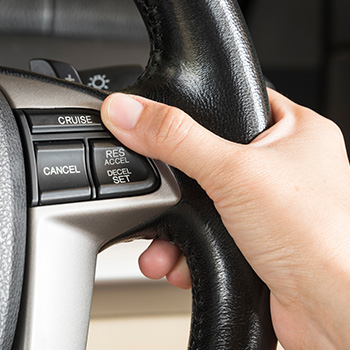Ralph Teetor and the History of Cruise Control
 Cruise control is a wonderful invention that helps us avoid speeding tickets and gives our feet a break on long drives. Although almost all drivers have used cruise control at some point, very few drivers know much about the feature’s origins or about the man who invented it. Ralph Teetor invented the cruise control device for modern motor vehicles… and he was blind.
Cruise control is a wonderful invention that helps us avoid speeding tickets and gives our feet a break on long drives. Although almost all drivers have used cruise control at some point, very few drivers know much about the feature’s origins or about the man who invented it. Ralph Teetor invented the cruise control device for modern motor vehicles… and he was blind.
Ralph Teetor’s Childhood & Career
A shop accident at the age of five took Teetor’s sight away, but he quickly learned how to develop his other senses and tap into his passion for mechanics. In fact, his increased abilities to hear and sensitivity to touch made him better able to diagnose and fix mechanical problems.
Despite his lack of sight, Teetor went on to attend the University of Pennsylvania to pursue an engineering degree and become a highly respected mechanical engineer. After graduating, he joined his family’s business, which later transformed into the Perfect Circle Corporation and designed and manufactured piston rings. This company provided piston rings to Packard, General Motors, Chrysler, Studebaker, and other major car companies. Teetor became the Vice President of Engineering for Perfect Circle, and later the President. He also worked to develop technology for steam turbine rotors used in torpedo boat destroyers during World War I.
The Early Cruise Control
As early as the late 1700s, engineers began using cruise control-type technology to control steam engines. Ralph Teetor was personally inspired to create cruise control for cars after a few too many frustrating drives with his lawyer, who had a nasty habit of speeding up and slowing down too frequently. Teetor designed improved piston rings and patented a gear shift, which he sold to the Bendix Corporation in the 1920s. He developed cruise control in the 1940s and patented it in the early 1950s.
How Cruise Control Works
Cruise control takes over the throttle of a vehicle to maintain a steady speed that the driver sets. Cruise control adjusts a car’s speed by adjusting the throttle position. But it does this by actuating the throttle valve by a cable connected to an actuator rather than pressing a pedal. Drivers can set the cruise control with switches typically marked as ON, OFF, RESUME, SET, ACCEL, and COAST. Cruise control devices allow you to accelerate or decelerate by one mph with just the tap of a button and are designed to disengage as soon as you press the brake pedal. Additionally, most cruise control devices won’t engage at speeds below 25 mph.
The Modern Cruise Control
Over the years, cruise control has been called “Controlmatic”, “Touchomatic”, and “Pressomatic.” It was first offered in top car models in the late 1950s. Today, it’s an invaluable feature on cars in the U.S. and far more common on American cars than European ones. But with worsening traffic conditions in large and mid-size cities it is unfortunately becoming less and less useful. However, cruise control remains a favorite feature among road trippers and an enduring accessory for that speedy driver who has a lead foot. And for this, we have Mr. Ralph Teetor to thank!
Categorized in: Driving, Technology
